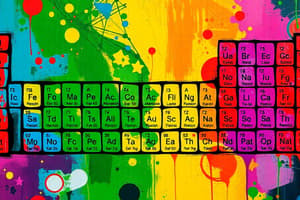Podcast
Questions and Answers
What type of chemical reaction involves breaking down complex substances into simpler ones?
What type of chemical reaction involves breaking down complex substances into simpler ones?
- Single displacement reaction
- Synthesis reaction
- Decomposition reaction (correct)
- Triple displacement reaction
In the periodic table, what trend can be observed as you move across a period?
In the periodic table, what trend can be observed as you move across a period?
- Atomic size generally decreases (correct)
- Elements become less reactive
- Atomic size generally increases
- Electronegativity increases
Which state of matter consists of electrically charged particles and is typically found in high-energy environments like stars?
Which state of matter consists of electrically charged particles and is typically found in high-energy environments like stars?
- Solid
- Gas
- Liquid
- Plasma (correct)
What type of bond occurs when an atom transfers electrons to another atom, leading to oppositely charged ions?
What type of bond occurs when an atom transfers electrons to another atom, leading to oppositely charged ions?
What is the main characteristic of a solid state of matter?
What is the main characteristic of a solid state of matter?
Which type of chemical reaction involves exchanging ions between reactants?
Which type of chemical reaction involves exchanging ions between reactants?
What are the three main components of an atom?
What are the three main components of an atom?
What determines the element that an atom represents?
What determines the element that an atom represents?
In which part of an atom do protons and neutrons reside?
In which part of an atom do protons and neutrons reside?
What occurs during a chemical reaction?
What occurs during a chemical reaction?
Which part of an atom orbits around the nucleus in defined energy levels?
Which part of an atom orbits around the nucleus in defined energy levels?
What is the main focus of chemistry as a science?
What is the main focus of chemistry as a science?
Flashcards are hidden until you start studying
Study Notes
Chemistry
Chemistry is a fundamental science that studies the properties and behavior of matter and its various forms, including elements and compounds. It involves understanding how atoms interact with one another to form molecules, which can then participate in chemical reactions that change their properties or form new substances altogether. In this article, we will explore the basics of chemistry, covering atomic structure, chemical reactions, the periodic table, states of matter, and molecular bonds.
Atomic Structure
Atoms are the basic building blocks of all matter. They consist of three main components: protons (positively charged particles), neutrons (neutral particles), and electrons (negatively charged particles). Protons and neutrons reside within the nucleus of an atom, while electrons orbit around it in defined energy levels called electron shells. The number of protons determines what element an atom represents; the number of neutrons is variable, leading to different isotopes of each element.
Chemical Reactions
A chemical reaction occurs when two or more substances react together to produce different products. These reactions involve the rearrangement of atoms between reactants or the breaking and formation of chemical bonds, resulting in changes to the physical and chemical properties of the substances involved. Some common types of chemical reactions include synthesis (combining substances to make a new compound), decomposition (breaking down complex substances into simpler ones), and double displacement (exchanging ions between reactants).
Periodic Table
The periodic table organizes all known chemical elements based on their atomic structure and properties. Elements are arranged in rows called periods and columns called groups, reflecting trends in their atomic sizes, electronegativities, and other characteristics. As you move across a row (period), atomic size generally decreases, while moving down a column (group) often corresponds to increasing atomic size. This organization provides valuable information about elements, making it easier to predict and understand their chemical behaviors.
States of Matter
Matter exists in four distinct states: solid, liquid, gas, and plasma. Solid objects have a fixed shape and volume due to strong intermolecular forces holding the particles tightly packed together. Liquids maintain a constant volume but take the shape of their container, indicating weaker intermolecular attractions. Gases expand to fill their container and show little cohesion among individual particles. Plasma, the fourth state, consists of electrically charged particles (ions and free electrons) and is typically found in high-energy environments like stars.
Molecular Bonds
Bonds form between atoms to create molecules. There are several types of molecular bonds, including ionic, covalent, and metallic bonds. Ionic bonds occur when an atom transfers electrons to another atom, forming oppositely charged ions that attract one another. Covalent bonds result from sharing electrons between atoms, with bond strength depending on the electronegativity difference between them. Metallic bonds are formed by the delocalized electrons within a metal's conduction band, allowing for the flow of charge and heat throughout the material.
In summary, chemistry is a diverse field encompassing the study of atomic structure, chemical reactions, the organization of elements in the periodic table, the classification of matter into states, and the formation of molecular bonds. Understanding these concepts helps us comprehend the world around us and develop innovative technologies to address modern challenges.
Studying That Suits You
Use AI to generate personalized quizzes and flashcards to suit your learning preferences.




